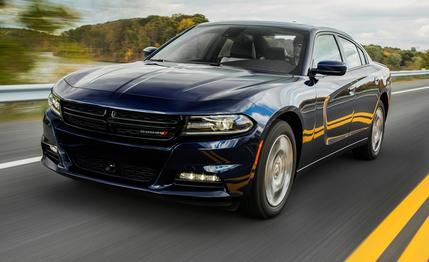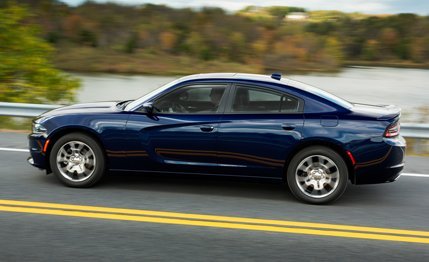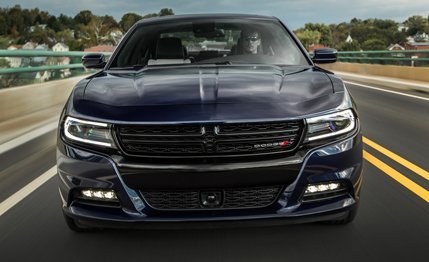 First Drive Review
First Drive Review
In our ideal world, all Dodge Chargers would arrive packing V-8 power. In that alternate reality, where performing smoky burnouts is considered a patriotic duty and watching The Dukes of Hazzard reruns has displaced baseball as our national pastime, it would be an act of treason to deliver a Charger with fewer than eight cylinders.
Reality, unfortunately, can be a real downer. Littered with buzz-killing responsibilities like turning a profit, meeting CAFE requirements, and amortizing development and production expenses, making it in the real world these days takes a well-rounded starting lineup. For the 2015 Dodge Charger, that means enough variants to hit all the price and performance points across the spreadsheet, from the top, er, uh, dog Hellcat Charger, which starts just shy of $65K, right down to the V-6–powered 2015 Dodge Charger SE and SXT models that start out with a base MSRP of $28,990.
When the 2015 Charger emerged from the design studio, only the roof and rear doors remained unchanged from the previous model. It’s clearly curvier with some softer edges. The designers tell us their inspiration for the grille came from the 1969 car and that its forward-leaning tilt is meant to give it the stance of a superhero. We’ll grant Dodge that one, but our take is that while the old grille was retro-modern Americana, the new one displays a more modern, worldly take on the crosshair design while maintaining a seriously sinister attitude. (SRT Chargers get their own fascia.) The side scallops, which took on an exaggerated appearance in the 2011-model-year makeover, have been refined, and the mounting point of the C-pillar has been moved even farther rearward to deliver a fastback appearance. There’s no way Dodge would leave its signature “racetrack” taillamp signature out of the equation; the entire ring glows softly whenever the headlights are on.

Resisting the urge to plunge through the Charger’s windows Duke-boy style—our Charger drive took place in West Virginia, just a hog’s tail from the Dukes’ territory in Georgia—we went traditional and curled our paws underneath the husky door handles for access. Sliding behind the new three-spoke wheel reveals the same spacious interior dimensions that sizable drivers have come to know and love. For 2015, though, some refreshed surfaces, instrumentation, and minor control-input changes pay big dividends. A new, highly stylized yet restrained instrument-surround insert—Dodge calls it an “aluminum-lithograph driver bezel”—exudes an upscale look and feel, but it’s let down by the acres of textured plastic that cover the top of the dash. Although soft to the touch and light-years better than the plastics of just a few years ago, it still feels a bit industrial, like the material that might cover the gripping surfaces on a piece of exercise equipment. That said, a low-key matte finish mitigates the effect, while attractive stitched-fabric door upholstery and redesigned seating helps keep things looking and feeling luxe, something that can’t be said for the Abu Ghraib–grade benches of the previous car.
Chrysler’s familiar 292-hp 3.6-liter Pentastar V-6 returns for duty in 2015, pumping the same 260 lb-ft of twist through the ZF-designed eight-speed automatic. Buyers looking for a slight advantage in the power department can spec the Rallye Appearance Group (not priced as of press time), which rounds the output up to a nice even 300 horsepower and 264 lb-ft. This bump comes courtesy of a cold-air intake, a “sport-tuned” exhaust, and a minor engine-calibration tweak. Either way, the six is still happy drinking regular unleaded, saving a few pennies at the pump.
Styling revisions aside, arguably the biggest change to hit the humble V-6 Charger models for 2015 is that they now use electric power steering. With three modes to choose from—Normal, Comfort, Sport—this helps the Charger perform its best trick, making 120.2 inches of wheelbase and two tons of curb weight feel considerably smaller than those figures imply. While the ratio remains the same at 14.4:1 and 2.6 turns lock-to-lock (16.5:1 and 3.1 for AWD models), switching to Comfort mode lightens the effort for parking-lot maneuvers, and Sport provides a nice—if somewhat artificial—weighty feel that complements the discernible on-center valley. Normal mode, as you might guess, splits the difference; we used it only long enough to find the setting button on the intuitive Uconnect system’s touch display. Combined with the stout and firmly damped chassis, the steering points the car just where you ordered, until you ask too much and the front tires begin to howl in a duet of understeer.
We were also pleased to find that the electronic shifter, formerly an anti-intuitive device that often required a glance at the dash to determine which gear you had selected, has been modified with clear detents that telegraph changes in a more traditional fashion. The eight-speed automatic is standard for 2015, and the octo-box shifts quietly and capably, virtually disappearing in around-town driving. (There is no manual-transmission option in the cards for the 2015 Charger, regardless of trim level or engine.) Full-throttle inputs are met with a prompt response, the transmission holding gears until redline or the driver orders a change via the shift selector or the optional wheel-mounted paddles. It’s been a while since we last had some seat time in a Charger equipped with the Pentastar V-6 and eight-speed-automatic powertrain, but the almost stunningly low interior-noise levels in the 2015 model had us wondering whether Dodge had stuffed the body panels full of foam rubber. The Dodge folks tell us this isn’t so, that the NVH reduction largely results from continual refinement of the platform, which, we must point out, can trace its roots back more than a decade. The brakes use single-piston calipers front and rear, and although they never let us down or exhibited fade, we wish Dodge would get its low-MSRP gods to concede to making the more capable dual-piston front units from the V-8 cars standard across the range.

For 2015, Dodge restricts the AWD option to V-6-equipped models (last year the AWD option extended to the Charger R/T with the 5.7-liter V-8); adding AWD to either the SE or SXT trim will add $3000 to the bottom line, bringing the MSRPs to $31,990 and $33,990.
As long as you’re not expecting V-8 levels of excitement, it’s hard to pick apart the entry-level Charger’s well-matched powertrain. Its EPA fuel-economy rating of 19 mpg city/31 highway (18/27 with AWD) only illustrates how far they’ve finessed it: In 2010, the base car was EPA-rated at 18/26 mpg, and its 2.7-liter V-6 made a meager 178 hp. Anyone paying off a five-year note and trading a 2010 Charger for this 2015 model is going to think the new one feels muscular even in base trim.
A Charger is a big car, but like a heavyweight contender, it’s got some moves and is eminently comfortable in its skin. In the end, enthusiasts may find the most desirable quality of the V-6 Charger is that its bottom-line-boosting sales volume and contribution to Fiat-Chrysler’s CAFE standing makes possible the insanity of the Charger SRT Hellcat. To everyone else, it’s a fine large sedan for real-world money.